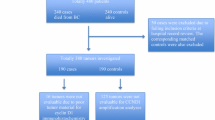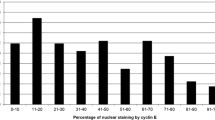Abstract
Background
The overexpression or amplification of tumor suppressor and proto-oncogenes are important factors in the progression of breast cancer. Recent attention has focused on the cyclin genes, whose involvement in signal transduction pathways regulate cell cycle progression. The amplification of the cyclins D1 and D3 genes usually leads to loss of normal growth control and is thought to play an important growth regulatory role in tumor development and progression. In this report, we investigate the association of altered cyclin expression with other prognostic indicators (histological grade, lymph node status, estrogen receptor, p53, and c-erbB-2) in the progression of human breast cancer.
Materials and Methods
Surgical tumor specimens were obtained from 16 breast tubular ductal, and invasive ductal carcinomas and grafted onto gnotobiotic nude (nu/nu) mice. The expression diversity and distribution of the localization of the protein products of the c-erbB-2, cyclins Dl and D3, p53, and estrogen receptor were characterized immunohistochemically and the results in the original tumor (T0) were compared with those in the tumors that developed in nude mice (T1) xenografts.
Results
The T0 tumors exhibited a diversity of cellular morphology in the tumor matrix and diversity in expression of these proteins. These specific changes were also preserved in the T1 tumors. Whereas 67% of the T1 tumors exhibited high numbers of estrogen receptor-positive nuclei, only 50% of these tumors grew when grafted onto nude mice. The histological grade (14/15 were G2 to G3) and metastatic malignancy in the lymph nodes (10/15) did not appear to be related to tumor growth in the nude mouse. There was no relationship between those tumors which exhibited high percentages of c-erbB-2- and p53-positive cells and growth in nude mice. A strong association (p < 0.001) was observed between the overexpression of cyclin D1 transcripts in the T0 tumors and the continued growth of the T1 tumors in nude mice. In the T1 tumors, both cyclins D1 and D3, estrogen receptor, and p53 were observed in 49% to 86% of the cells of the T1 tumors examined; the number of cells expressing c-erbB-2 protein varied widely in these tumors.
Conclusions
The results indicate that the tumor matrix exhibits a diversity in the level of phenotypic expression of genes involved in cellular growth of breast tumors in both the T0 or T1 host environment. Changes in cyclin activity appear to correlate with the vigorous level of breast tumor growth and progression.

Similar content being viewed by others
References
Clarke R. (1996) Human breast cancer cell line xenografts as models of breast cancer: The immunobiologies of recipient mice and the characteristics of several tumorigenic cell lines. Breast Cancer Res. Treat. 39: 69–86.
Brunner N, Boysen B, Romer J, Spang-Thomsen M. (1993) The nude mouse as an in vivo model for human breast cancer invasion and metastasis. Breast Cancer Res. Treat. 24: 257–264.
Kurian P, Milo GE, Noyes I. (1992) Metabolism of benzo[a]pyrene in human skin xenografts. Cancer Biochem. Biophys. 13: 23–31.
Chen JC, Shuler CF, Zhang CX, Schuller DE, Milo GE. (1991) Histopathologic comparison between human oral squamous cell carcinomas and their xenografts in nude mice. Oral Surg. Pathol. 71: 457–463.
Price JE, Polyzos A, Zhang RD, Daniels LM. (1990) Tumorigenicity and metastasis of human breast carcinoma cell lines in nude mice. Cancer Res. 50: 717–727.
Price JE, Zhang RD. (1990) Studies of human breast cancer metastasis using nude mice. Cancer Metastasis Rev. 8: 285–297.
Giovanella BC, Vardeman DM, Williams LJ, Taylor DJ, Ipolyi PD, Greef PJ, et al. (1991) Heterotransplantation of human breast carcinomas in nude thymus mice: correlation between successful heterotransplants. Int. J. Cancer 47: 66–71.
Fu X, Le P, Hoffman RM. (1993) A metastic orthotopic-transplant nude-mouse model of 282 human breast cancer. Anticancer Res. 13: 901–904.
Mehta RR, Graves JM, Warso MA, Gupta TKD. (1995) Overexpression of mutant p53 and c-erbB-2 proteins and breast tumour take in mice. Br. J. Cancer 72: 1160–1164.
Lewko WM, Vaghmar R, Hubbard D, Moore M, He Y-J, Chang L, et al. (1990) Cultured cell lines from human breast cancer biopsies and xenografts. Breast Cancer Res. Treat. 17: 121–129.
Quénel N, Wafflart J, Bonichon F, De Mascarel I, Trojani M, Durand M, et al. (1995) The prognostic value of c-erbB2 in primary breast carcinomas: A study on 942 cases. Breast Cancer Res. Treat. 35: 283–291.
Molina R, Jo J, Filella X, Zanon G, Pahisa J, Muñoz M, et al. (1996) C-erbB-2 oncoprotein in the sera and tissue of patients with breast cancer. Utility in prognosis. Anticancer Res. 16: 2295–2300.
Becker K, Dosch J, Gregel CM, Martin BA, Kaina B. (1996) Targeted expression of human O6-methylguanine-DNA methyltransferase (MGMT) in transgenic mice protects against tumor initiation in two-stage skin carcinogenesis. Cancer Res. 56: 3244–3249.
Horne GM, Anderson JJ, Tiniakos DG, McIntosh GG, Thomas MD, Angus B, et al. (1996) p53 protein as a prognostic indicator in breast carcinoma: A comparison of four antibodies for immunohistochemistry. Br. J. Cancer 73: 29–35.
Cox LA, Chen G, Lee EY-HP. (1994) Tumor suppressor genes and their roles in breast cancer. Breast Cancer Res. Treat. 32: 19–38.
Bosari S, Viale G. (1995) The clinical significance of p53 aberrations in human tumours. Virchows Arch. Int. J. Pathol. 427: 229–241.
Allred DC, Elledge R, Clark GM, Fuqua SA. (1994) The p53 tumor-suppressor gene in human breast cancer. Cancer Treat. Res. 71: 63–77.
Andrews BJ, Mason SW. (1993) Gene expression and the cell cycle: A family affair. Science 261: 1543–1544.
Boulikas T. (1994) Control of DNA replication by protein phosphorylation. Anticancer Res. 14: 2465–2472.
Strobl JS, Wonderlin WF, Flynn DC. (1995) Mitogenic signal transduction in human breast cancer cells. Gen. Pharmacol. 26: 1643–1649.
Wuarin J, Nurse P. (1996) Regulating S phase: CDKs, licensing and proteolysis. Cell 85: 785–787.
Zhang S-Y, Caamano J, Cooper F, Guo X, Klein-Szanto AJP. (1994) Immunohistochemistry of cyclin D1 in human breast cancer. Am. J. Clin. Pathol. 102: 695–698.
Gillett C, Smith P, Gregory W, Richards M, Millis R, Peters G, et al. (1996) Cyclin D1 and prognosis in human breast cancer. Int. J. Cancer 69: 92–99.
Schuuring E. (1995) The involvement of the chromosome 11q13 region in human malignancies: Cyclin D1 and EMS are two new candidate oncogenes—a review. Gene 159: 83–96.
Bartkova J, Zemanova M, Bartek J. (1996) Abundance and subcellular locilisation of cyclin D3 in human tumours. Int. J. Cancer 65: 323–327.
Chen J, Milo GE, Shuler CF, Schuller DE. (1996) Xenograft growth and histodifferentiation of squamous cell carcinomas of the pharynx and larynx. Oral Surg. Oral Med. Oral Pathol. Oral Radiol. Endodont. 81: 197–202.
Milo GE, Trewyn RW. (1982) In vitro transformation of cultured human diploid fibroblasts. In: Banbury Report, Vol. 12. Cold Spring Harbor Laboratory, Cold Spring Harbor, NY, pp. 3–13.
Yohn J, Lehman TA, Kurian P, Ribovich M, Milo GE. (1988) Benzo[a]pyrene diol epoxide I modification of DNA in human skin xenografts. J. Invest. Dermatol. 91: 363–368.
Wani G, D’Ambrosio SM. (1995) Differential expression of the O6-ATase gene in normal human breast and skin tissue: In situ mapping of cell type specific expression. Mol. Carcinog. 12: 177–184.
Shan-Rong S, Key ME, Kalra KL. (1991) Antigen retrival in formalin-fixed, paraffin-embedded tissues: An enhancement method for immunohistochemical staining based on microwave oven heating or tissue sections. J. Histochem. Cytochem. 39: 741–748.
Allred DC, O’Connell P, Fuqua SAW, Osborne CK. (1994) Immunohistochemical studies of early breast cancer evolution. Breast Cancer Res. Treat. 32: 13–18.
Ozzello L, De Rosa CM, Cantell K, Kauppinen HL, Habif DV, Sr. (1995) Regression of human breast cancer xenografts in response to intralesional treatment with interferons α and γ potentiated by tumor necrosis factor. J. Interferon Cytokine Res. 15: 839–848.
Gottlieb TM, Oren M. (1996) p53 in growth control and neoplasia. Biochim. Biophys. Acta Rev. Cancer 1287: 77–102.
Carson DA, Lois A. (1995) Cancer progression and p53. Lancet 346: 1009–1011.
Pujol P, Hilsenbeck SG, Chamness GC, Elledge RM. (1994) Rising levels of estrogen receptor in breast cancer over 2 decades. Cancer 74: 1601–1606.
Clarke R, Skaar T, Baumann K, Leonessa F, James M, Lippman J, et al. (1994) Hormonal carcinogenesis in breast cancer: Cellular and molecular studies of malignant progression. Breast Cancer Res. Treat. 31: 237–248.
Nagai MA, Marques LA, Yamamoto L, Fujiyama CT, Brentani MM. (1994) Estrogen and progesterone receptor mRNA levels in primary breast cancer: Association with patient survival and other clinical and tumor features. Int. J. Cancer 59: 351–356.
Makris A, Powles TJ, Dowsett M, Allred C. (1995) p53 protein overexpression and chemosensitivity in breast cancer. Lancet 345: 1181–1182.
Lipponen P, Ji H, Aaltomaa S, Syrjänen S, Syrjänen K. (1993) p53 protein expression in breast cancer as related to histopathological characteristics and prognosis. Int. J. Cancer 55: 51–56.
Friedrichs K, Gluba S, Eidtmann H, Jonat W. (1993) Overexpression of p53 and prognosis in breast cancer. Cancer 72: 3641–3647.
Martinazzi M. (1994) Expression of p53 oncoprotein in different histological types of breast carcinoma. Am. J. Pathol. 144: 205.
Merlo GR, Venesio T, Taverna D, Marte BM, Callahan R, Hynes NE. (1994) Growth suppression of normal mammary epithelial cells by wild-type p53. Oncogene 9: 443–453.
Smith HS, Lu Y, Deng G, Martinez O, Krams S, Ljung B-M, et al. (1993) Molecular aspects of early stages of breast cancer progression. J. Cell. Biochem. 53(Suppl. 17G): 144–152.
Elledge RM, Allred DC. (1994) The p53 tumor suppressor gene in breast cancer. Breast Cancer Res. Treat. 32: 39–47.
Katoh A, Breier S, Stemmler N, Specht S, Blanock K, D’Amico F. (1996) p53 protein expression in human breast carcinoma: Lack of prognostic potential for recurrence of the disease. Anticancer Res. 16: 1301–1304.
Barbareschi M, Caffo O, Doglioni C, Fina P, Marchetti A, Buttitta F, et al. (1996) p21WAF1 immunohistochemical expression in breast carcinoma: Correlations with clinicopathological data, oestrogen receptor status, MIB1 expression, p53 gene and protein alterations and relapse-free survival. Br. J. Cancer 74: 208–215.
Singleton TP, Strickler JG. (1992) Clinical and pathological significance of the c-erbB-2 (HER-2/neu) oncogene. Pathol. Ann. 1: 165–190.
Hurst J, Maniar N, Tombarkiewicz J, Lucas F, Roberson C, Steplewski Z, et al. (1993) A novel model of a metastatic human tumor xenograft line. Br. J. Cancer 68: 274–276.
Symmans WF, Liu J, Knowles DM, Inghirami G. (1995) Breast cancer heterogeneity: Evaluation of clonality in primary and metastatic lesions. Hum. Pathol. 26: 210–216.
Allred DC, O’Connell P, Fuqua SAW. (1993) Biomarkers in early breast neoplasia. J. Cell. Biochem. 53(Suppl. 17G): 125–131.
Szöllösi J, Balázs M, Feuerstein BG, Benz CC, Waldman FM. (1995) ERBB-2 (HER2/neu) gene copy number, p185HER-2 overexpression, and intratumor heterogeneity in human breast cancer. Cancer Res. 55: 5400–5407.
Stanton PD, Cooke TG, Forster G, Smith D, Going JJ. (1996) Cell kinetics in vivo of human breast cancer. Br. J. Surg. 83: 98–102.
Han EK-H, Sgambato A, Jiang W, Zhang Y-J, Santella RM, Doki Y, et al. (1995) Stable overexpression of cyclin D1 in a human mammary epithelial cell line prolongs the S-phase and inhibits growth. Oncogene 10: 953–961.
Sgambato A, Han EKH, Zhang YJ, Moon RC, Santella RM, Weinstein IB. (1995) Deregulated expression of cyclin D1 and other cell cycle-related genes in carcinogen-induced rat mammary tumors. Carcinogenesis 16: 2193–2198.
McIntosh GG, Anderson JJ, Milton I, Steward M, Parr AH, Thomas MD, et al. (1995) Determination of the prognostic value of cyclin D1 overexpression in breast cancer. Oncogene 11: 885–891.
Acknowledgements
This work was supported by grants R21-CA66193 (S.M.D. and G.E.M.), RO1-CA25907 (G.E.M.), and P30-CA16058 (S.M.D.) from the National Cancer Institute.
Author information
Authors and Affiliations
Corresponding author
Additional information
Communicated by R. Sager.
Rights and permissions
About this article
Cite this article
Wani, G., Noyes, I., Milo, G.E. et al. Expression of Molecular Biomarkers in Primary Breast Tumors Implanted into a Surrogate Host: Increased Levels of Cyclins Correlate with Tumor Progression. Mol Med 3, 273–283 (1997). https://doi.org/10.1007/BF03401680
Accepted:
Published:
Issue Date:
DOI: https://doi.org/10.1007/BF03401680




